Get The Buzz – Planting for Bees
There are many reasons why bees are so very important to us, but one fact really stands out to us and makes us appreciate how hugely important our buzzy friends are:
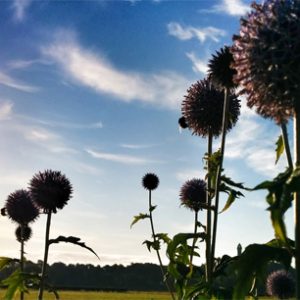
The bees loving the echinops in our garden
1. Lavender
A favourite with so many of our clients. It loves dry, sunny positions so if you don’t have the correct sort of soil in your borders consider having a pretty pot filled with lavender on a sunny corner of our patio where you can enjoy the
sights, smells and buzzy sounds from it!
2. Catmint
Nepeta is loved by cats and bees alike! It is similar to lavender with its pretty flowers and silvery blue leaves and gives off a lovely aromatic scent as you brush past.
3. Verbena
We love verbena, particularly verbena bonariensis. It grows really easily, even in our heavy clay soil and gives statuesque height to the border. You may need to give the plant a bit of support if your garden catches the wind and be warned, this plant does like to self seed. It provides beautiful winter interest if it’s not cut down in Autumn.
4. Sedum
continues to provide interest through the winter. It’s easy to split and create new plants so if you know a friend who has some then go ask for a piece now!
5. Eryngium
interest if you don’t cut it down after it has flowered.
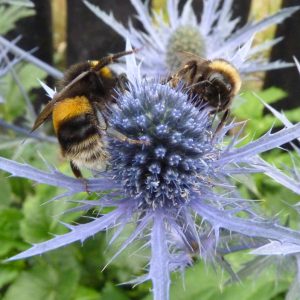
6. Buddleja
Probably best known for attracting butterflies but bees are also partial to a buddleja. The long cone-like flowers prove too irresistible for them.
7. Sunflowers
Now, who can resist the big yellow smiley face of a sun flower? It’s the perfect plant to get kids involved in gardening. Get them to have a competition with their friends to see who can grow the tallest plant and use it to explain to them the importance of encouraging bees into the garden.
8. Hebe
Hebes are a great structural shrub which can be a lovely alternative to buxus in your garden if you are looking for a rounded shape to provide an interesting form. But bees love their flowers too making it a well rounded (excuse the pun) plant for the garden.

A bee on sedum
9. Foxgloves
We regularly see foxgloves growing profusely at the sides of the road so it shows just how easy they are to grow. They will self seed furiously so once you have them you will get free plants forever. Bees just love snuggling up inside one
of the bell like flowers and having a nice big feed.
10. Heathers
Again, a plant we often see growing in the wild in Scotland and if you have acidic soil in your garden you will be able to grow these well and keep our fuzzy friends happy.
If we have whetted your appetite, then there are literally THOUSANDS of plants* which bees will love and there will be plenty to suit your garden and soil. The perfect for pollinators list published by the RHS gives you more information than you could ever wish for.
The Plight of the Bumblebee
Hopefully all the yummy crops in your garden are growing well and you can start to see berries, fruit and veg appearing on your plants. If you can, it is likely that pollinating insects like bumblebees have been out and about in your garden. Bumblebees look really cute and with big bodies and tiny wings don’t look like they should able to fly. Like me they aren’t happy being told what they can’t do so they do fly just to spite the mathematician boffins! I thought I’d find out a bit more about them and how they help in our gardens and what we can do to help them in return.
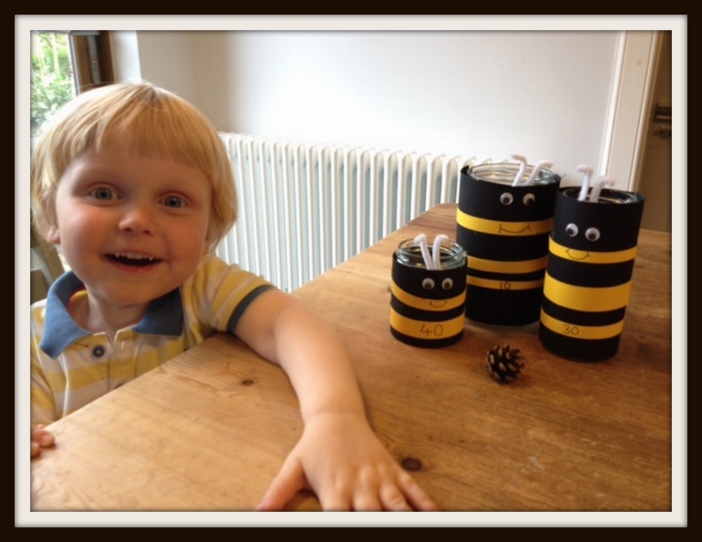
Read on to find out what I’m making…..
Bumblebee facts
- There are 250 types of bumblebee in the world, 24 in the UK but you’re likely only see 6-8 kinds in your garden.
- You can mainly tell the types apart by the colour and number of their stripes.
- They live in nests of 50-400 bees in the ground or in piles of old leaves.
- Each nest has one Mummy who is in charge (just like my home then!) She is called the Queen. The daughters all do the work in the nest and the few sons leave home when fully grown and sleep on flowers.
- The Queens sleep all winter (a lovely long sleep called hibernating) and then wake in Spring and lay eggs to start a whole new nest.
- Bumblebees have 5 eyes! They have 3 larger ones at the sides their heads and 3 little eyes on top of their head.
- Female bumblebees can sting, but only if you scare them. Their stings are like those of wasps- they don’t have any sticky-out bits to get stuck in the skin so the bumblebee can remove it and sting again. Honeybees can only sting once.
- Their buzzing noise isn’t made by their wings but by vibrating muscles!
- Their left and right wings don’t flap together, each flaps on its own.
- The speed and noise that their buzz makes (its frequency) is perfect for releasing large amounts of pollen from tomatoes. Now almost every single European tomato we buy is due to a bumblebee’s buzz, wow that’s a lot of buzzing as I can eat LOADS of tomatoes all on my own!
How Bumblebees help us
Bumblebees drink the sugary juice called nectar that’s in flowers and they collect yellow dust called pollen to feed to their babies. When they do this they “pollinate” the flowers and that lets them turn into fruit and veg. They are faster pollinators than honeybees as they can visit twice as many plants every minute and all their hairs means nectar sticks all over them. Being bigger they can carry more pollen and so can go on longer foraging trips. They are hardy insects, not put off by drizzle or winds- perfect for Scotland. They are happily active at temperatures down to 10°C. They aren’t as scared of enclosed spaces such as greenhouses as honeybees are, so do more of the pollinating on indoor crops. In fact some bumblebees are grown just to pollinate crops such as tomatoes, courgettes, strawberries and peppers grown by farmers inside greenhouses. In the UK bumblebees, solitary bees and hoverflies also pollinate 97% of our wild flowers.
Helping bumblebees
Two types of bumble bee have disappeared from our gardens in the last 80 years. If we don’t want to lose any more types we can grow their favourite plants in our gardens. Wild flowers such as foxgloves, daisies and buttercups have lots of nectar and pollen. Our countryside used to be filled with wild flower meadows but these have been disappearing. We can plant these in our garden. Or we can plant tasty herbs such as rosemary, chives, thyme, sage and marjoram to feed bumblebees and us.
Remember to try to plant different flowers that bloom from Spring through to Autumn- we’d not be happy if we could only eat in June and July! Also, different types bumblebees have shorter or longer tongues so need flowers of different sizes too so they can find their perfect fit- just like Goldilocks and the 3 bears! Some bees manage get around this problem by nibbling a teeny hole in the base the flower so they can still get access to the nectar- how smart are they?!
Learn how bumblebee friendly your garden is by finding out your Bee kind score and then you’ll get help picking other favourite bumblebee flowers to plant alongside those you already have. My garden got a score of 2604, not too bad as the average in Scotland is 2061.
If you ever come across a bumblebee lying on the ground looking tired/unwell you can try to help by feeding them a mixture of 1 teaspoon of sugar in 1 teaspoon of water and placing that near the bee’s head. It should then stick out its really, really long tongue, lap up the sugary water and then use the energy to fly off. Never try to keep a bumblebee inside, they need to be outside foraging, building a nest or hibernating.
Identifying bumblebees
It’s fun to learn what types of bumblebee you have in your garden. You need to begin by making sure it is a bumblebee and not a honey bee. Bumblebees are normally bigger and hairier than honeybees or solitary bees. Next work out what colour its tail is and how many bands it has on its body. Finally look to see if there is a ball of pollen (or a shiny surface ready cover with pollen) on its back legs. You can even get involved in the Bumblebee Conservation Trust’s Bee Watch survey. You just need to take a photograph of the bumblebees that you see and then upload it to their webpage telling them the date and time the photo was taken. The tools help you work out the type of bumblebee (don’t worry an expert bumblebee identifier -what a cool job – will check your answer later) and your bumblebee will become part of their survey results. All the results will help brainy people check on what types of bumblebees are found where and how many of them there are just in case any types need extra special help from us.
Bumblebee craft
Here’s a great way to use old jars of plastic bottles and turn them into a fun craft project and game.
You’ll need:
- empty, clean jars or plastic bottles (if using bottles get a grown up to cut off the top third)
- black, yellow and white paper or card
- googly eyes (or you can just draw eyes on)
- pipe cleaners
- glue
- marker pen
- scissors
- a small pinecone (or you can use a little ball)
To make:
- Start by covering the outside of your jar with glue.
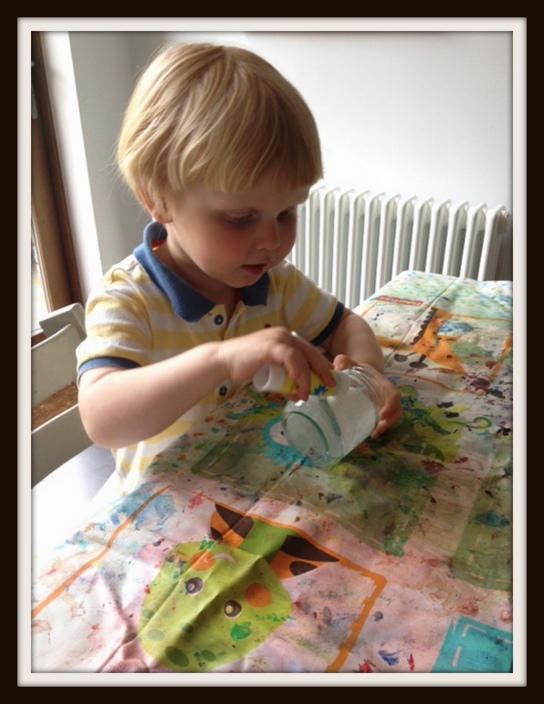
Gluing on the black body- be extra careful when holding glass jars
2. Wrap a piece of black paper around the jar.
3. Cut the yellow paper into strips
4. Glue a couple of yellow strips around the black jar to make bumblebee stripes.
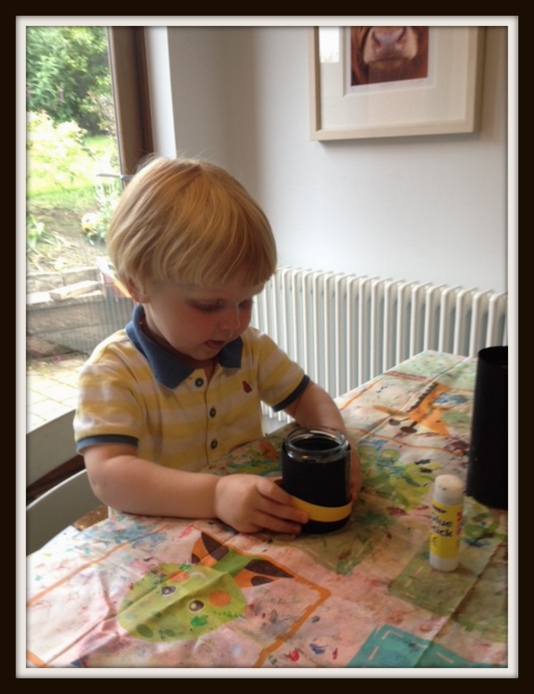
This bumblebee will have almost as many yellow stripes on his tummy as me!
5. Stick on googly eyes near the top of jar.
6. Make antennas out of pipe cleaners and slip this in between paper and jar.
7. Draw on a face.
8. Cut out some wings from white card and glue these onto back of jar.
9. Write numbers on the front to tell everyone how many points you’ll get for throwing the cone into that bumblebee.
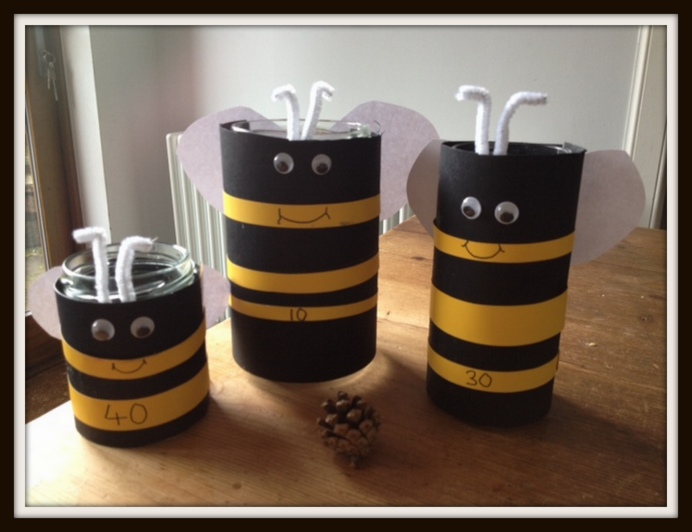
My hungry bumblebee family
Now you have a fun game where you can take turns to throw the pinecone “pollen” into the hungry bumblebee’s tummy. See who can score the most points!
Remember, if you enjoy eating tomatoes and strawberries or looking at pretty wild flowers as much as I do, please help out in the plight of the bumblebees and grow a few more bee friendly plants in your garden.
Big hugs
Euan xx
Take A Walk On The Wild Side…
Do you fancy being a wildlife warden in your own nature reserve? If you go about creating a wildlife garden correctly (and not just leaving a bit of your garden to go wild) you will be rewarded with countless visits by new birds, insects, animals and amphibians. You might even get an increase in crop yield from your veg and fruit. And helping out wildlife doesn’t mean you have to compromise on design either.
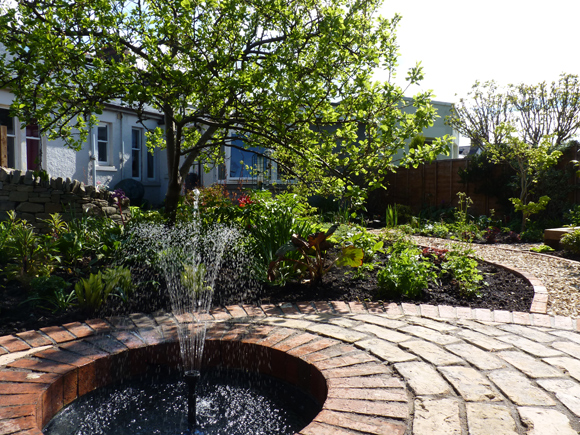
A wildlife garden doesn’t need to compromise on style
Why should we encourage wildlife into our gardens?
Lots of indigenous creatures like hedgehogs, sparrows, stag beetles and song thrushes are continuing to struggle in the UK. But with more than 16 million gardens in the UK, imagine the difference we could make if we all did a little bit more in our gardens to help.
We have recently redesigned the gardens at Jupiter Urban Wildlife Centre for the Scottish Wildlife Trust. It’s been incredibly rewarding seeing how our designs can make a real difference to wildlife on that reclaimed industrial wasteland and look beautiful at the same time. Whether you are thinking of a whole new garden design that centres around wildlife or if you have an area you could designate for them, there are lots of ways you can really make a difference.
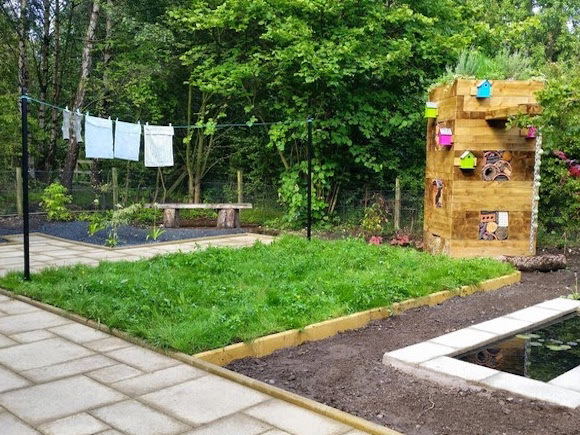
The new Jupiter Urban Wildlife Centre which Vialii designed features funky bug hotels as well as a pond and living walls
Before you embark on your wildlife garden…
If you’re looking at a new garden design, you first need to determine just what you want to use your garden for and who will be using it. Once you have the basic structure of patios, seating areas, paths, veg areas, borders and lawns sorted you can then start thinking about the smaller creatures who also enjoy hanging out in your garden (wildlife that is, hopefully you’ve already thought about children and pets!)
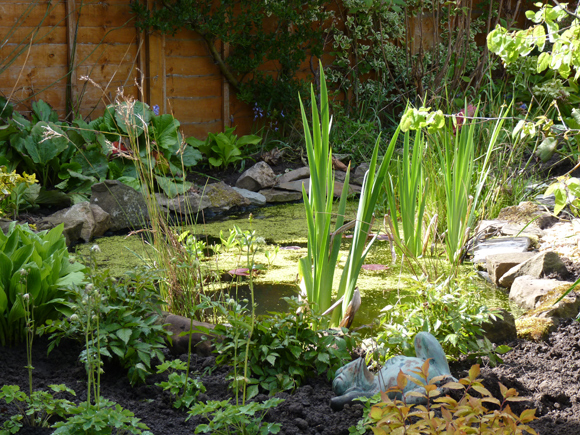
The pond we built in this Edinburgh garden is a haven for wildlife
Things to consider in a wildlife garden
Pond
The single most beneficial item you can introduce in your wildlife garden design is a pond. Ideally don’t add fish as they will eat visiting wildlife which kind of defeats the purpose! Make sure one side of the pond has a more gradual sloping side to allow creatures easy access.
Planting
By being intelligent with the choice of flowers you can provide pollen and nectar for bees, butterflies and other pollinating insects. That has the added benefit of helping with any pollination in your veg and fruit plots. Pick a range of flowers so that nectar and pollen is available from spring (e.g crocuses) through to autumn (e.g. Michaelmas daisies). Also ensure you have a mix of trees and shrubs. Larger trees are great at providing food and shelter for a range of wildlife. Also, 96% of our native wildflower meadows have been lost in the last 60 years so by including one in your garden you can help restore the balance. They are relatively low maintenance and you can even mow a path through it to add intrigue and encourage exploration in your garden design.
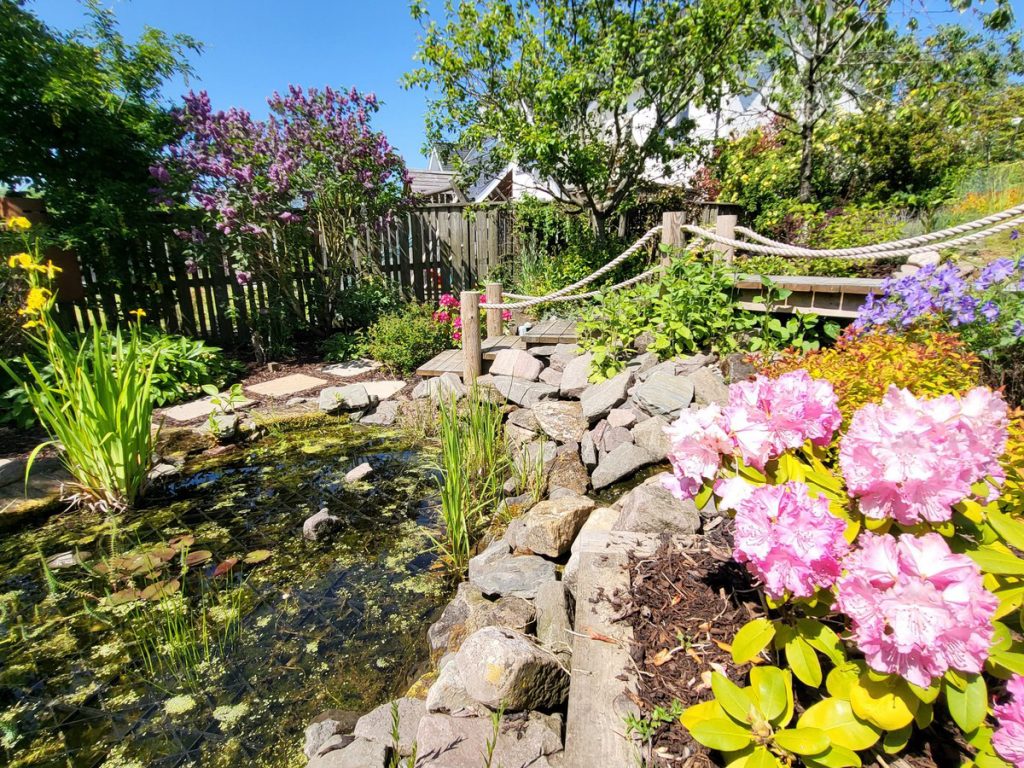
A stunning garden pond we created
Wood piles
Decaying wood is increasingly rare in the countryside so by leaving a pile of dead wood you’ll benefit stag and bark beetles and their grub as well as many fungi. You can be creative with the structure of the pile and can make it look quite architectural or funky.
Create alternative habitats
Another more rustic idea is to make a rock garden that will attract important flying insects such as mason bees. During their 6-8 week life they will help pollinate your fruit trees. They need a source of mud but with our climate in Scotland this is not normally a problem! They also need a shelter. Mason bees’ nesting holes are ideally 5mm diameter and 15cm deep. You can provide paper straws or bamboo tubes in these dimensions and perhaps tuck them in an upturned flowerpot or buy a commercially available option.
Solutions for smaller spaces
If you’re short on space or can’t commit to a complete garden design, you can still help out wildlife. You could plant up a hanging basket with ox-eye daisies, lavender, wild pansies and honeysuckle to encourage bees and butterflies. Or just fill a planter with wildflower seeds rather than having a full meadow area.

The correct planting will help encourage wildlife into your garden
If you hanker after a pond but think you’ve not got the space you could create a pond in a pot. You just need a water tight container – how about up-cycling an old Belfast sink with the hole plugged? Place 2-4cm of peat-free compost in the bottom and cover with gravel. Fill the container with water (rainwater is ideal but if using tap water leave for 2-3 days). Then plant up once the water has cleared. Use oxygenating plants which will survive in water. You can make a little shelf and plant marginals. All you need to do then is keep the water levels topped up (again using rainwater to reduce likelihood of algal blooms) and enjoy the new wildlife.
Think about your boundaries
Another option for a small wildlife garden is to make a functional item such as a fence into a living boundary by covering them with wildlife friendly flowering and berry producing plants. Honeysuckle bark makes good nest building material for birds and the flowers attract a plethora of insects. Clematis plants provide burst of colour for us and attract insects and provide shelter for birds. Ivy is another excellent option as the flowers provide autumn nectar for honey bees and red admiral butterflies, birds love the berries and lots of wildlife can use the plant for shelter.
If you are interested in creating a wildlife garden and need some help, contact us for a free design consultation.
Thanks for reading,
All at Vialii
The Bees Knees
Hi, it’s me, Lulu, The Secret Blogger again! So, the bees knees. What a funny saying. I mean, do bees even have knees? And if so, why are they so good? Anyway, knees or not, bees are very good things. And not just because I can say the word “bee” very well plus I can do a good impression of a buzzy bee! We need bees for lots of reasons…
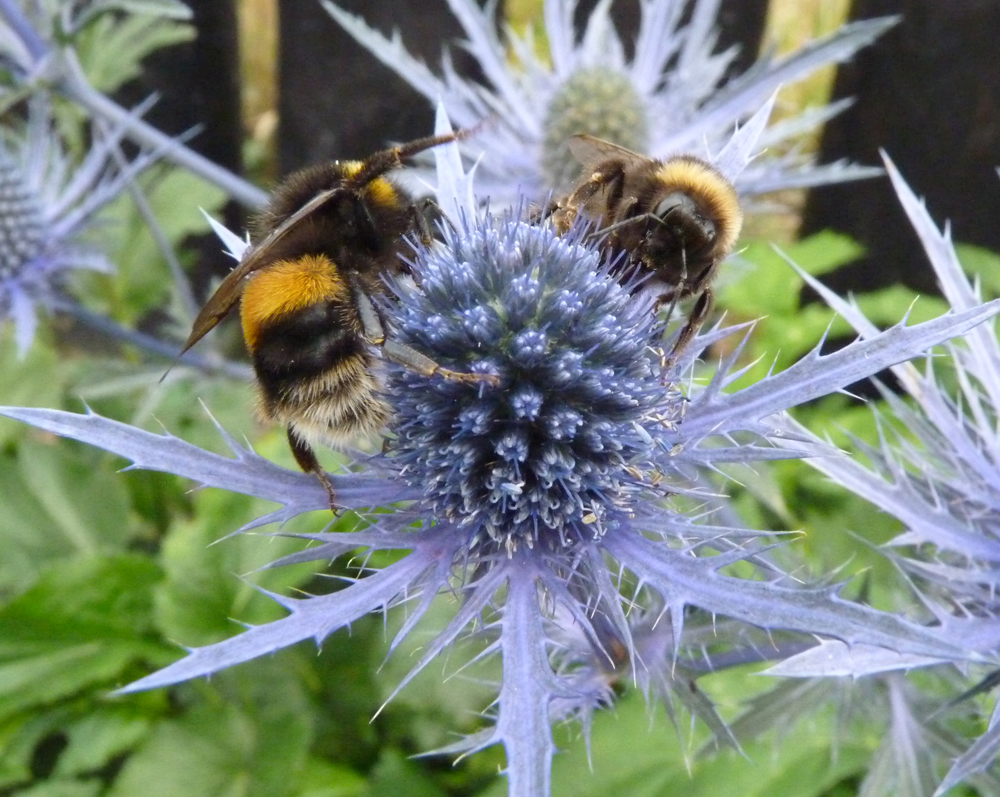
Bees on eryngium
Why Bees Are Important
Bees pollinate a wide range of crops, vegetables, fruits and plants
- Without bees crops will be reduced and we wouldn’t have enough to eat (1)
- Without bees plants wouldn’t survive
- Without bees birds will be left without sufficient food
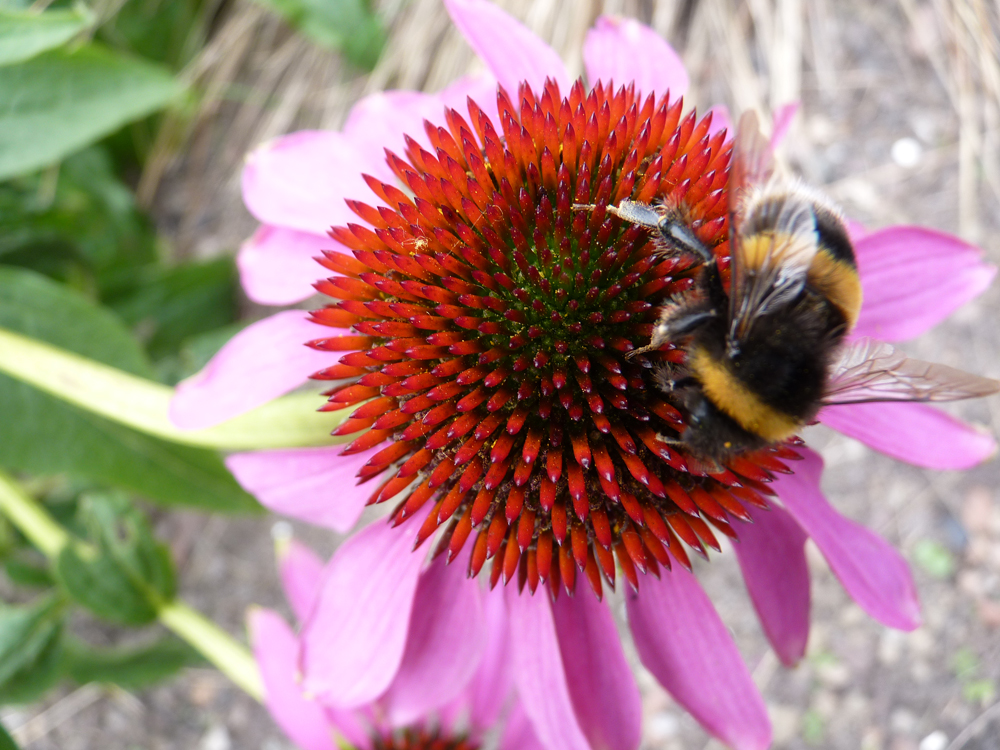
Echinacea is popular with bees
Fingerprint Bumblebees
- Yellow paint
- Black paint
- Paper or card
- Cover your thumb in yellow paint.
- Press your thumb on to a piece of paper at whatever angle you want your bee to be flying.
- Dip your little finger into black paint.
- Gently dot on a head and make an even smaller dot for the sting at the back of your bee.
- Make three side by side dots (about the same size as the sting) in the middle for the black stripe.
- Put your index finger into the black paint. Stamp many times onto a piece of scrap paper or paper towel until almost all the paint is gone. Then stamp a wing above the body at a slight angle and a second wing above the body at an opposite angle.

Make a bumble bee from finger prints
So, even when you are indoors you can have your very own cheery bumble bee! Thanks to the crafty people at DLTK for this idea.
Do You Do Room Service?
Everyone likes a nice, comfy home and bugs are no different from the rest of us. Many are happy to set up home under a pile of leaves or logs. But why not go a step further and create your own bug version of Gleneagles in your very own back garden with a 5 Star Bug Hotel? Here’s how to make a bug hotel…
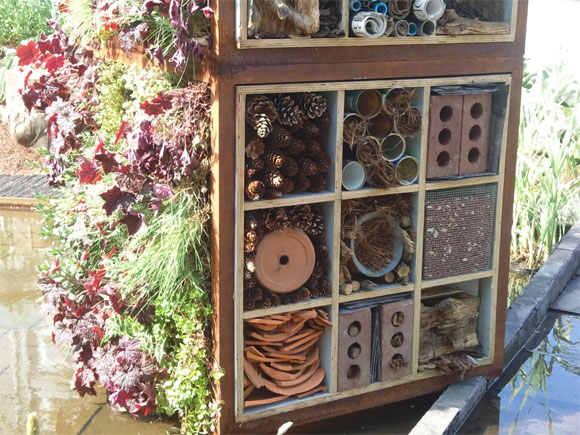
A stunning bug hotel from the Chelsea Flower Show
Many of us like to have a neat and tidy garden and by doing so we often eradicate the natural habitats bugs can call home. Or in a new garden with lots of hard landscaping and container planting there may be limited places for invertebrates to set up home. Bug hotels are purpose built structures which can be as simple or grand as you like.
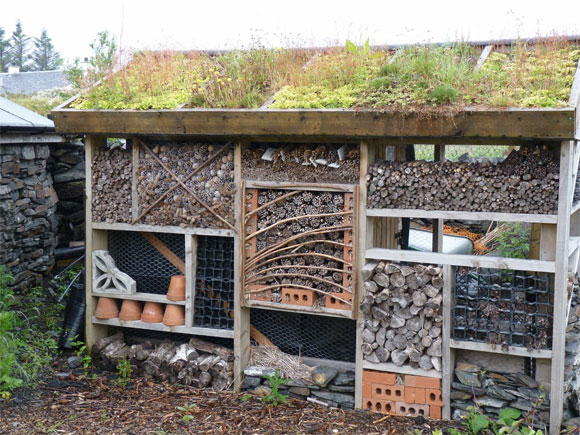
A bug hotel on Seil Island with a green roof
Designing A Bug Hotel
The first rule of creating a bug hotel is to incorporate a variety of materials and different shapes and sizes of nooks and crannies. Different bugs have different requirements so in order to be diverse and encourage as much wildlife as possible into your garden make sure you use a wide array of materials. Offer everything from single rooms up to penthouse suites with a spa thrown in for good measure!
[[image:blog/blog-roomservice-3.jpg=A stunning bug hotel from the Chelsea Flower Show using lots of different materials]]
If you can, do a rough design of what you want your bug hotel to look like. Most bug hotels are made from reclaimed material thus making them cheap and easy to build as well as good for the environment. You could use some old pallets which are easy to get hold of to create the different layers of your bug hotel. Or if you are feeling adventurous you could create a real focal point in your garden by building a tower similar to the fantastic work of art at the Chelsea Flower Show a few years ago.
Building A Bug Hotel
Building a bug hotel is a wonderful project to build with children and you can encourage them to collect the materials you are going to use. Many of these you will have lying around the house and you can ask friends and family to donate to your hotel. Ideal materials include:
- Bamboo canes
- Egg cartons
- Pieces of slate
- Straw
- Logs (drill the ends for even more places for bugs to set up home)
- Broken terracotta pots
- Old bricks
- Old roof tiles
Pack the various materials into different sections of your “hotel” and soon you will have created a home which looks interesting and will have wide appeal.
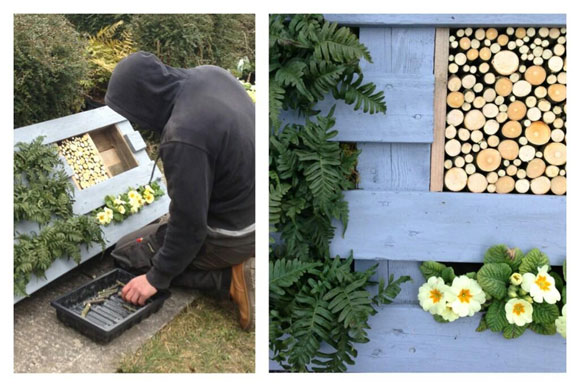
A pallet incorporating a bug hotel at RHS Cardiff Show
Bug Central
So what sort of bugs might pack their bags and move into their new home? Well , common sights include mason bees, woodlice, ladybirds, spiders, beetles and centipedes. By encouraging these bugs into your garden they will help you combat the pests which eat your plants and ruin your grass. Great guests to have and ones which always be welcome back! Wonder if you get Trip Advisor for beetles…
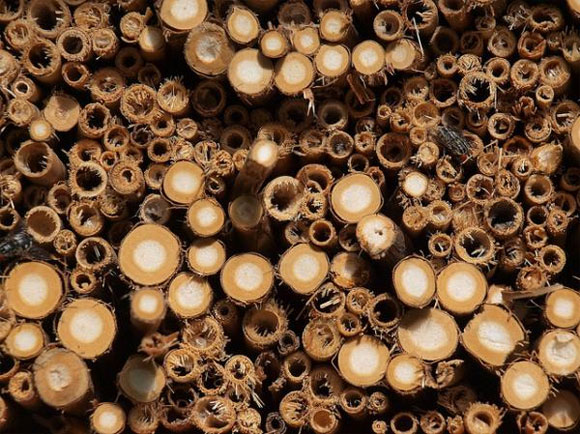
Lots of bamboo canes make an ideal home
If you want advice on building a bug hotel or other ways of turning your garden into a haven for wildlife please get in touch.
For more information on making your own bug hotel please visit our blogs Make Your Own Bug Hotel and How To Make A Bug Hotel.
All at Vialii